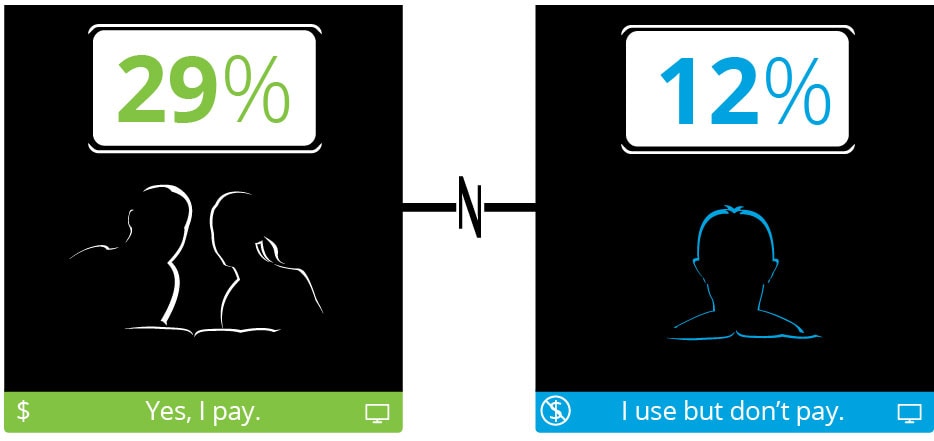Password sharing and battle lines in streaming wars has been saved

Perspectives
Password sharing and battle lines in streaming wars
Game of 'who owns'
Traditionally, streaming video services have let password sharing go unregulated, but as competition intensifies, could they be forced to reconsider their stance?
Pay or use live TV streaming subscription service?

Copyright © 2019 Deloitte Development LLC. All rights reserved. Source: Deloitte analysis based on data from Digital media trends survey, 2019.
Tens of millions1 of people are expected to watch this Sunday’s final-season premiere of Home Box Office’s (HBO) Game of Thrones. Given recent trends, the network is undoubtedly betting that a significant proportion of viewers can result in new subscribers, from either a pay-TV provider or its own direct-to-consumer (DTC) service, HBO NOW.
The explosion of streaming services has popularized the binge-friendly strategy of releasing full season episodes, simultaneously. However, the traditional release cycle—and, more specifically, a season premiere—still translates into big business for TV networks.
Traditionally, series premieres have triggered sizable increases in new subscribers. In April 2015, for example, the Season 5 premiere of Game of Thrones coincided with the launch of HBO NOW. This marked an inflection point for the industry—and a portent of similar offerings from rival networks.
US consumer streaming subscriptions (69 percent), of which DTC services are a subset, now exceed traditional Pay TV subscriptions (65 percent),2 as many users add to or replace their existing video service provider with flexible and low-cost services delivered over the internet. Networks, through DTCs, allow consumers to stream their scheduled programming, through live TV streaming services, and HBO’s coming season premiere could also drive more subscribers, who no longer have a Pay TV service, to its DTC service.
Although original content premieres often spur subscriber acquisition growth, they can also fuel password sharing. Some estimate that this represents 20 percent of lost revenue opportunities.3 Although streaming companies allow sharing overall, what if sharing accounts for more activity than what the industry estimates?
Deloitte’s recently released Digital media trends survey, 13th edition gives some evidence that companies could be underestimating the extent of password sharing. According to the survey, 29 percent of consumers pay for live TV streaming services, with an additional 12 percent saying they use, but do not pay
Since this ratio is meant to reflect non-revenue generating subscribers, it could be pared slightly to discount non-payers (e.g. children) that use a log-in of a payer family member (e.g. parent). Streaming companies allow for some sharing within a household,
The bad news for streaming services is that the prevalence of “mooching” could grow, driven by a wave of price hikes over the past 12–18 months.5 These have raised the cost of subscriptions by 15 to 50 percent,6 contributing to some subscriber churn. And it’s arguable that some of these former subscribers could become new moochers. This could also exacerbate some other pressure on subscribers. Additional data from the survey shows that “subscription fatigue” related to managing multiple subscriptions is becoming more pronounced, with 47 percent of consumers saying it is a cause of frustration.
However, many DTC companies may be perfectly happy for mooching to continue, considering it expands viewership and exposure for all original content, not just top performers. In addition, mooching could also help reduce churn, given that “generous” paying subscribers must consider their moochers before they let their subscriptions lapse.
The streaming market is about to become very crowded with major technology and studios entering the fray with their own service later this year. As competition intensifies among streaming companies it will be interesting to watch if companies regulate password sharing more vigorously.
This charticle authored by David Ciampa on April 11, 2019.
Endnotes
1 Bill Keveney, "'Game of Thrones' by the numbers: Counting episodes, Emmys, dragons and deaths,” USA Today, March 11, 2019.
2 “Digital Media Trends Survey, 13th Edition,” Deloitte, March 2018.
3 Rande Price, “Password Mooching Costs Streaming Services Millions in Monthly Revenue,” Digital Content Next, March 6, 2019.
4 “Digital Media Trends Survey, 13th Edition,” Deloitte, March 2018.
5 James K. Willcox, “Netflix Price Hike Points to the Changing Math of Cord Cutting,” Consumer Reports, January 16, 2019.
6 Jefferson Graham, “Even with Price Hikes from Netflix and Hulu, Streaming Still Cheaper than Cable,” USA Today January 26, 2019.


